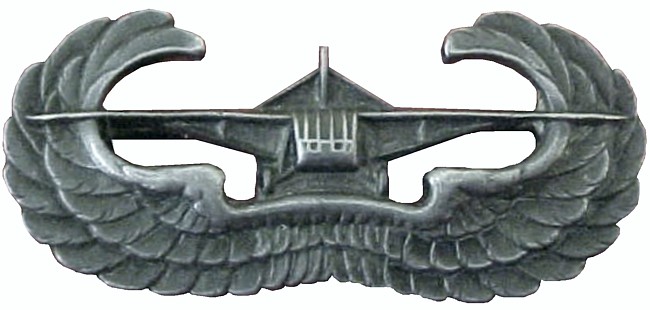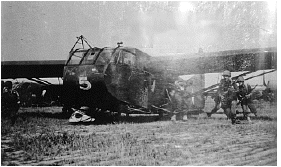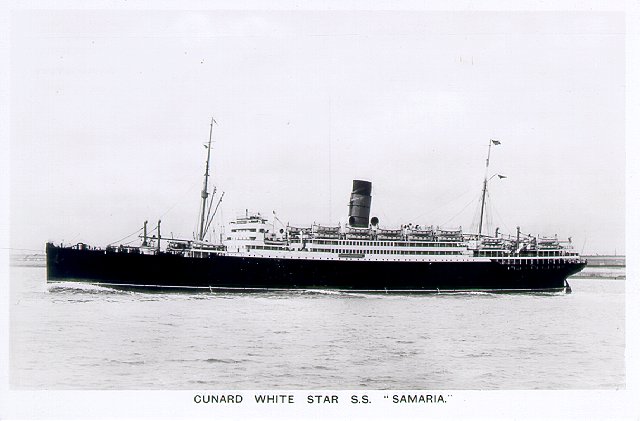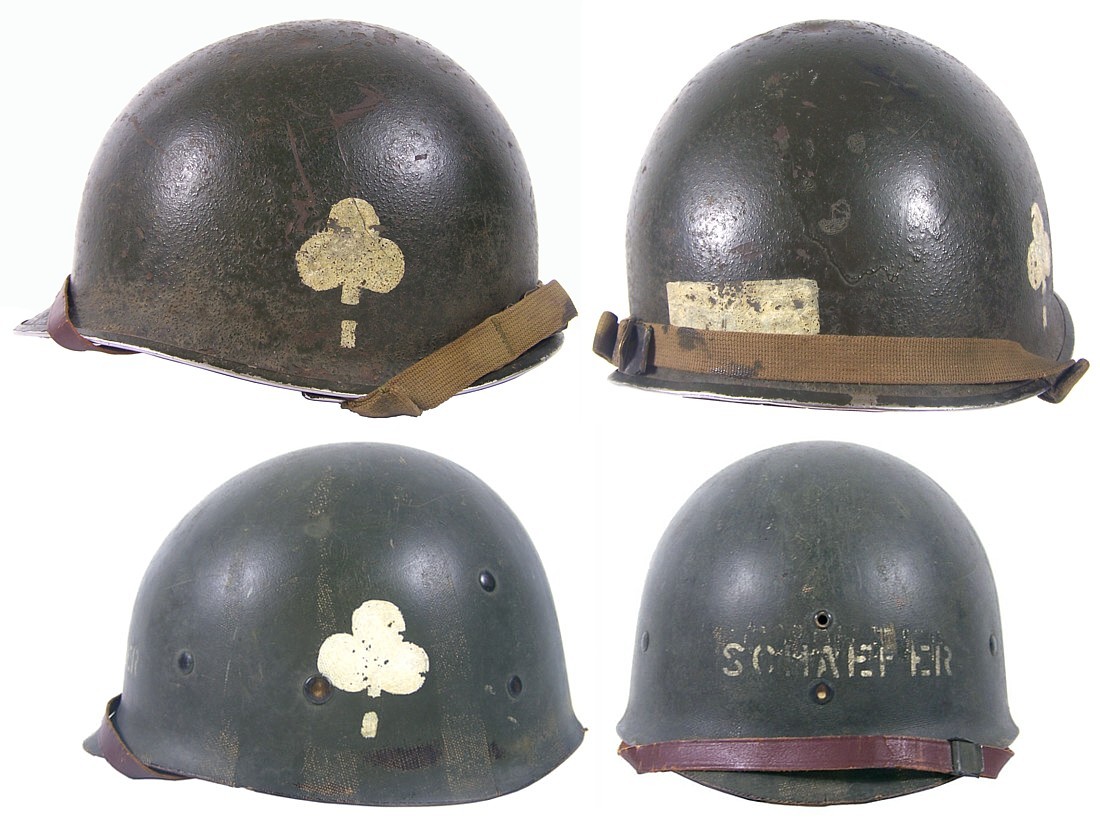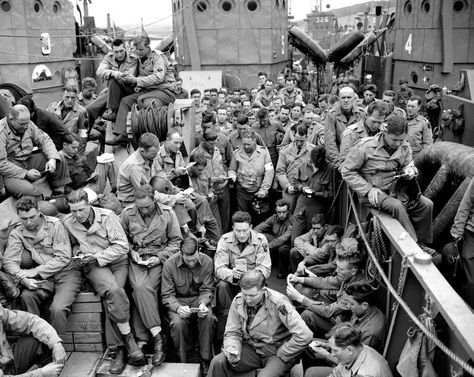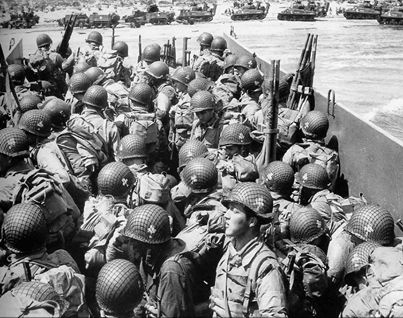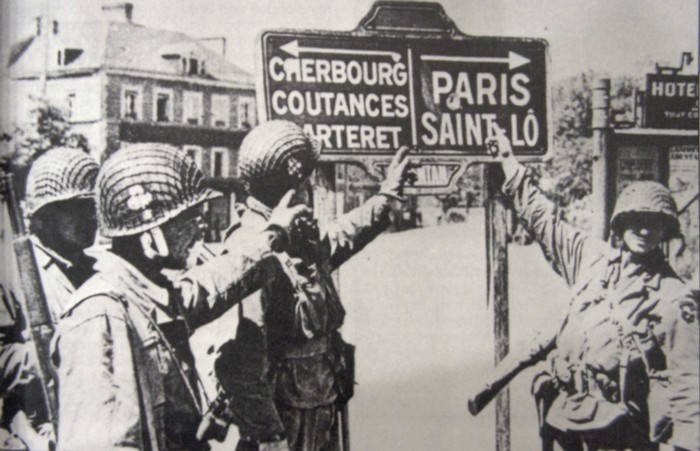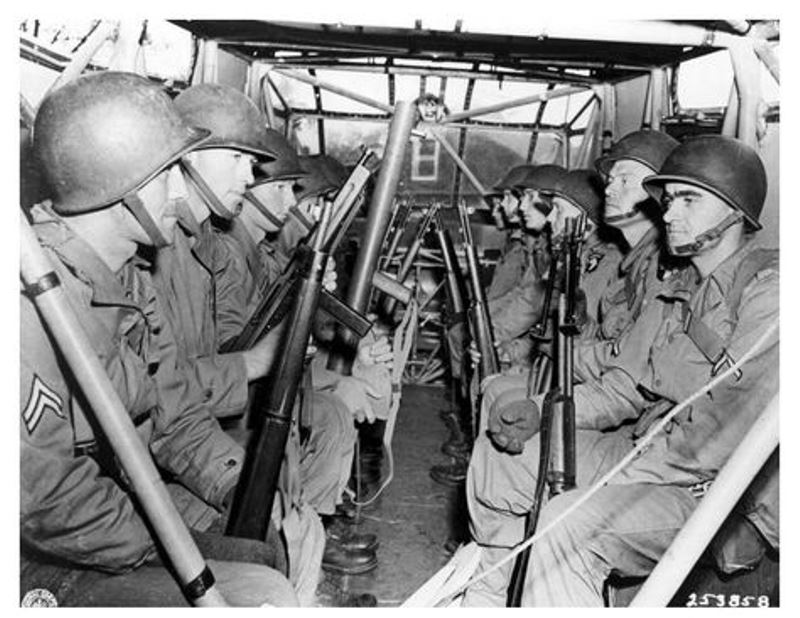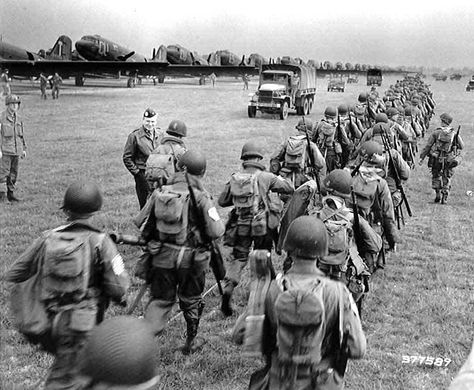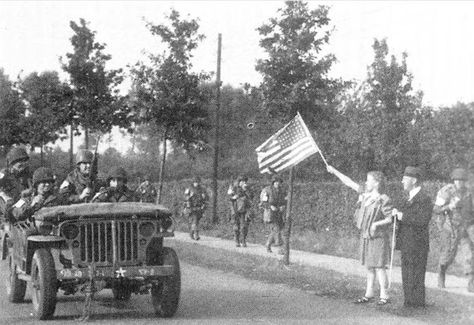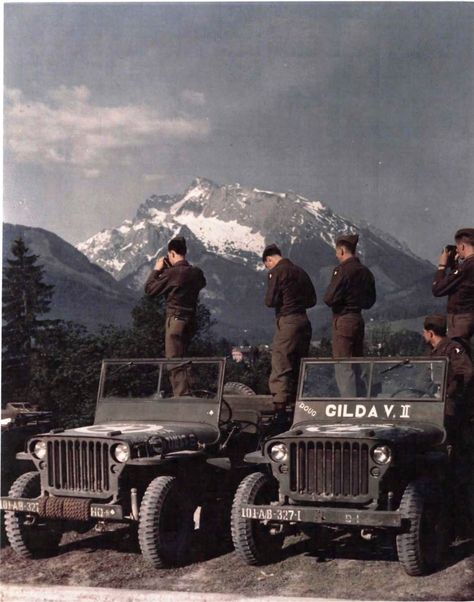F Company - 2nd Battalion - 327th Glider Infantry Regiment - 101st Airborne Division
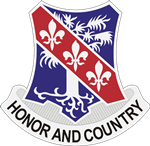 |
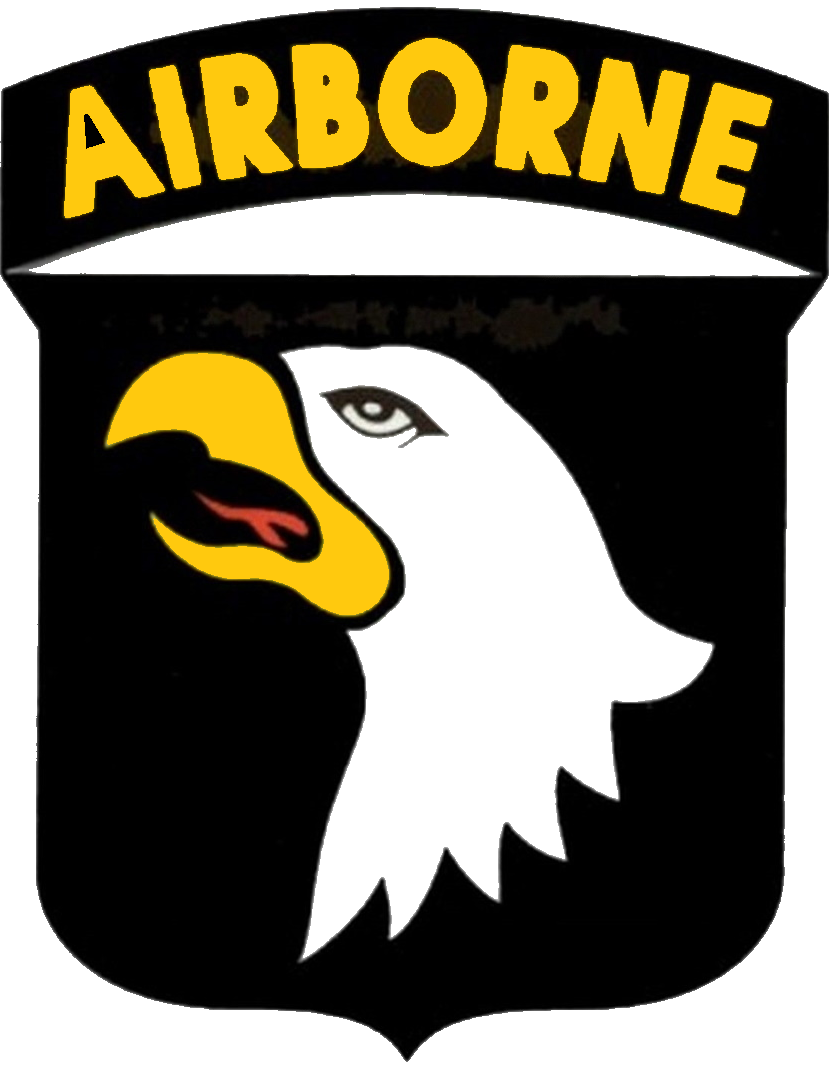 |
|
| 327th GIR Coat of Arms | 101st Airborne Division Shoulder Patch |
History of 327th GIR. 101st ABN
With the reactivation of the 82nd Infantry Division in March 1942, the 327th regimental colors were again unfurled. The 327th was originally organized as an infantry regiment in the summer of 1942 as part of the 82nd Infantry Division at Camp Claiborne Louisiana. As the airborne concept was pushed into further development because of the coming of war, the 82nd was chosen to become the first of four airborne divisions to be created during World War Two. During the final days of the units basic training, the men were to told by their commander, Major General Omar N. Bradley, that the Division was to be split to form a second Division, the 101st. Furthermore, he informed the men that the two divisions were to be Airborne, and the 327th was to be trained as Glider Infantry. The men were not sure about flying in gliders. Most of them had never even flown in a plane. Some men went AWOL, to return after a few days, but all knew that war was approaching and that they had to fight for their country.
On 15 August, 1942 the 327th Infantry became a Glider Infantry Regiment and was reassigned to the newly formed 101st Airborne Division. The Glider Regiments previously Members of the US 101st Airborne Division, 327th Glider Infantry pausing in the Bavarian Alps near Berchtesgaden, Germany for some photographs for the folks back home, before June 1945, before consolidation, consisted of two battalions each. Upon reorganization, they consisted of three battalions each. The six original 327th companies would constitute the 1st and 2nd Battalion as companies A, B, and C, and D, E, and F respectively; The 401st Glider Infantry Regiment (a sister Regiment) was deactivated and transferred its 1st Battalion to the 327th in the form of the new Companies G, H, and I.
Glider Qualification Wings
In the fall of 1942, the regiments headed to Ft. Bragg North Carolina to began training with the CG-4a Glider. Along the way the glider men were introduced to the paratroopers of the 502nd PIR. Many fights would break out between these two groups, as the paratroopers thought they were the best and that the glider troopers didn't have the "Right Stuff" to be Airborne Soldiers. Nevertheless, in North Carolina the men received glider training at Laurinburg-Maxton Army Air Base.
327th and CG-4A Glider Training
The first flights caused ill-effects on some of the men, who used their helmets since air sickness bags were not available at the time. As training with the gliders progressed it became more apparent that landing men by gliders was to be more dangerous than landing by parachute. Some of the landings were to result in serious injuries. Mostly broken arms and legs. On landing, gliders would slide out of control and crash into trees or fences. Some, upon landing, would slide in and the nose of the glider would dig in, causing the glider to tilt up vertically on its nose section, which caused the contents of the glider to break free of it's lashings and come crashing forward injuring Glider men and Glider Pilots alike.
Beginning December 8, 1942, each glider unit was sent to Laurinburg-Maxton Army Air Base in Maxton, North Carolina, where they trained for two months apiece. There were many other training exercises that the Division took part in. These included the Southern Big Pines area; the Camden Maneuver on March 23-28, 1943; and the Tennessee Maneuvers just to name a few. The airborne and glider units received similar physical training, and were overall the best-trained troops in the Army.
Arrival in England
SS Samaria, circa 1928
Converted into a troopship in 1939, Samaria was returned to Cunard in 1950
On September 5, 1943, the whole of the 101st Airborne Division departed New York and set sail for England. On September 15, 1943, the 327th GIR unloaded from the RMS Samaria (formerly the SS Samaria of the Cunnard White Star Line) at Liverpool, England. They were then moved to Camp Ranikhet near Reading, where they continued to train and learn about the British Horsa gliders. During the winter, code names and emblems were given to each unit. The 327th received the code name "Keepsake" and the "Club", or trefoil, emblem.
Helmet of Aloyse Schaefer (ASN 36220663) ; a Staff Sergeant in G Company, 2nd Batt. / 327th Glider regiment, 101st Airborne
A standard M1 helmet, as issued to all non-jump qualified soldiers of the 101st Airborne
The 327th participated in two Command Post exercises during December of 1943. The first exercise was on December 10-11, and the second was December 28-29. These exercises included parachute jumps, glider landings, and supply drops. In the early part of 1944 the troops began preparing for D-day with three different exercises. It was in March of 1944 that the 401st ABN was deactivated and it's 1st Battalion would stay with the 101st Airborne Division (AB) but would be sent to the 327th GIR as it's 3rd battalion.
On the 23rd March 1944, Prime Minister Winston Churchill and General Dwight Eisenhower visited Welford airfield to watch a demonstration jump by the 101st Airborne Division. The 53rd Troop Carrier Wing provided the C-47 transports and gliders whilst the 506th PIR, 327th GIR and 377th PFAB either jumped or landed by glider in large fields just outside the perimeter of the airfield. Churchill also reviewed the men and inspected various pieces of equipment including Horsa and CG-4A gliders fully loaded with either troops or equipment.
The first official maneuver/exercise in March 1943 was Exercise Beaver, which was held on March 27 - 31, 1944. Though this exercise was broken into several smaller exercises, ‘Beaver V’ was the US amphibious assault training exercise in the UK by Major General J. Lawton Collins’s US VII Corps of Lieutenant General Omar N. Bradley’s US 1st Army in preparation for the Utah Beach component of ‘Overlord’.
The second, Exercise Tiger, was held on April 23 - 30, 1944. During this exercise the 327th participated as a sea-borne unit. Confusion set in early and the 327th ended up bivouacked in sixteen different camps, spread over a 40-mile area.
The third, Exercise Eagle, was held on May 9 - 12, 1944, and was the dress rehearsal for the invasion of Normandy.
During these exercises the units involved were given different unit identifications. This was designed to prevent the Germans, who might intercept any of the radio transmissions, from knowing which units were actually participating. During this exercise the 327th was assigned the call sign "899th Tank Destroyer Battalion".
Normandy - D-Day
Members of 327th GIR during a religious service aboard a landing craft, before the D-Day invasion, June 5, 1944
In June 1944, the decision to drop both the 82nd and 101st Airborne Divisions simultaneously into Normandy reduced the number of available aircraft to tow the gliders for a glider assault. The 327th Glider Infantry Regiment was ordered to land across Utah Beach with the 4th Infantry Division on D-Day. Its mission was to move to Carentan to cut off the fleeing Germans. Although causalities were high, the mission was accomplished and the Regiment moved back to England to prepare for its next mission.
327th Lands on Utah Beach D+1
On D-day June 6th, 1941, the 3rd Battalion of the 327th landed just after noon and bivouacked near the beach. By the evening of D +1 the 1st and 2nd Battalions were assembled near St. Marie-du-Mont. On D+2 the 3rd Bn saw action near St. Come-du-Mont. At 2000 hours units of the 327th marched up to the bombed out wooden bridges south of the La Barquette Locks to relieve the 506th. There they held the riverbank from below the locks to the mouth of the Douve River.
The 327th began its way toward Carentan on June 9th, 1944. At 0145 hours, C Company, 1st Bn crossed the Douve River. By 0700 hours they occupied the village of Brevands and began their two-day fight up the south bank toward Carentan. At 2200 hours on June 10th the 327th attacked the hedge grove area just short of the Canal de Vire-et-Taute, and the 2nd Bn took up a position near a footbridge that connected the canal and the Douve River. On June 11th the 327th crossed the bridge at 1000 hours and advanced through the wooded area, where they became pinned down under heavy fire.
At 0500 hours on June 12th the 3rd Bn of the 327th renewed the attack from the Basin-a-Flot to the northeast. They received sniper fire and fire from the west end of town, which turned out to be covering fire. By 0700 hours they were in the town. Later that day, while trying to take the high ground just south of Montmartin-en Graignes, a hamlet five miles southeast of Carentan, the 327th less the 3rd Bn encountered German resistance. The resistance was heavy and consisted of small arms, mortars, and 88’s. They hooked up with the 29th Infantry Division and set up defensive positions on the high ground just as dark settled in.
On June 13th, the 327th was moved back to the rail line, where they held until June 14th. By June 15th they were on their way to Carentan. On June 16th they were put into line between the 501st and 502nd. On June 17th the 327th saw limited objective attacks to help push the outpost line forward. This was the last real fighting they had in the Normandy Campaign.
Members of the 327th in Carentan
On July 13, 1944, the 101st Divisions LST's pulled into South Hampton, England.
Back in England
During the summer of 1944 several missions were developed, but all were canceled as the lines of battle had moved so rapidly past the locations of the originally planned missions. The first was Operation Transfigure. The 327th was to assemble at the village of Chatonville, France after making a glider landing on August 19th. However, on August 17th General Pattons’ armor reached the area.
The second mission was code named "Limet 1". The gliders were to land and troops assemble southeast of Tourani, Belgium. They were to patrol east and south and be prepared to support the division if needed. The mission was called off when the British Second Guards Armor Division Took Tourani. But, it was not long before the 327th would see action. This time it would be in Holland, for Operation Market Garden.
Holland - Market Garden
Glider Troops ready for take-off
The next combat operation the Regiment would participate in would be Operation "Market Garden," the airborne invasion of Holland. The Regiment, along with allied units, endured 73 days of continuous combat. After the fighting settled down, the 327th occupied the front lines for 48 days until ordered to withdraw from Holland.The Regiment went back to France to rest and recuperate before the next operation.
Elements of the 327th march off LZ-W upon arrival D+2
On September 18, 1944, twenty-three gliders with the 327th left Ramsbury, fifty-eight left Alder Maston, and eighty with the 2nd Bn left Membury. On the 19th eighteen gliders left Welford, and forty-one with the 1st Bn left Chilboton. One glider with the 327th left Greenham Common on D+6 and on D+8 about 500 officers and enlisted men were brought into Holland.
On D-day the gliders were designated to land at Landing Zone - W (LZ-W). On the first day fifty-three of the seventy gliders landed without an accident. Three crashed on the LZ, and nine in other locations, two in friendly and seven in enemy territory. Two dropped in England and one went down in the channel. In all, two hundred and fifty-two men, thirty-two jeeps, and thirteen trailers were delivered by the regiment.
On D+1; which was made up of eighty percent of gliders, four hundred and twenty-eight of the four hundred and fifty gliders landed at LZ-W. They brought in two thousand five hundred seventy-nine men, one and forty-six jeeps, two bulldozers, one hundred nine trailers, and much more.
The D+2 landings did not go as well as the previous days. There was heavy fog and bad weather on the LZ. Only two hundred and nine of the three hundred and eighty-five gliders landed at LZ-W. Sixteen crashed in enemy territory and thirty-one in friendly areas. One thousand three hundred forty one men (three hundred fifty-four from 1st 327th), seventy nine jeeps, and forty guns were brought in. Many more were lost in the crashes.
On D+2 the 1st Bn 327th set up a perimeter after they beat back the Germans at Zon. C Company, while covering a four hundred-mile front south of the canal, was attacked by Germans on D+3. During D+4-5, the 327th was in Zon at landing zone area.
Members of the 327th Glider Infantry Regiment, 101st Airborne, driving from Eindhoven to Nijmegen,
Netherlands as part of Operation Market Garden, are cheered on by Dutch citizens about Sep 18, 1944.
Sept 22, 1944 found the 327th moving toward Vechel. The 1st Bn repulsed an attack by the Germans at the bridge. D+6 found seventy-seven of eighty-four gliders landing at LZW. One was with the 327th. The 327th continued to hold the bridge at Erp on D+7 and they defended the town from D+8-10. Two men of C Company, 1st Bn 327th died in Hein Ophensden at 1700 hours when two thousand artillery shells landed on their position on October 9th.
By mid-November units started to head back toward Mourmelon-le-groid. This stay did not last long.
The Ardennes - Battle of the Bulge
On 16 December, 1944, the Germans launched an offensive in the west through the Ardennes Forest. The 101st Airborne Division was ordered to the vitally important town of Bastogne. Bastogne was the key to the German counter-offensive and had to be held at all cost by the 101st. The Regiment arrived at Bastogne on 19 December following a hundred mile truck march. The 327th immediately assumed a defensive sector south of Bastogne.
On December 19th the 327th was sent out on patrol to crossroads X. At 1630 hours the 1st Bn was attached to the 501st and were put on the right flank near Neffe Wardon Mont.
By December 20th,the 2nd Bn was ordered to Marvie, and the 3rd Bn remained in Flomizoulle. The Germans had Bastogne, and the allies, surrounded. The 39th regiment reached the high ground 1km north of Remofosse thanks to the 327th.
On December 21st the 1st Bn 327th, relieved by the 501st, was sent southwest of Bastogne near the woods and ordered to set up a roadblock along the main highway, and to patrol Vileroox and Chenogne. Company B held up the 2nd Panzer at the road block southeast of tenneville.
By 22 December the Germans had completely surrounded Bastogne and on the 23rd the German Commander offered terms of surrender to General McAuliffe, the acting Division Commander. His reply was "Nuts." The German delegation, which had come through the 327th sector, were sent to Colonel Harper who had been given the responsibility of relaying General McAuliffe's response.
The Germans read the response and said they that they did not understand. Colonel Harper replied; "The reply is decidedly not affirmative. In plain English, it is the same as 'Go to Hell!' Although encircled and outnumbered, American forces withstood all attempts by the Germans to take their positions, including Germans crossing into their lines dressed in American uniforms.
The 327th Regiment had held for nine days, until relieved by the 4th Armored Division. Despite suffering heavy causalities, the Regiment took 750 prisoners, knocked out 144 Nazi tanks and 105 other enemy vehicles. For its actions as a unit in the defense of Bastogne, the 327th received the Regimental motto "Bastogne Bulldogs."
On December 23rd, at 1840 hours, a platoon of Company G of the 327th became surrounded on hill 500 south of Marvie. By 1900 hours they were overwhelmed by the 901st Panzergrenadier and never heard from again.
The 3rd Bn 327th encountered eighteen German tanks on their front during the battle of Champs on December 25th. Not one tank was able to get away. Much needed supplies were brought in on the 26th by eleven gliders, and thirty-five of fifty gliders on the 27th.
At 1745 hours on December 28th the 3rd Bn 327th, near Lutremage, south of Bastogne was attacked. Company F 327th along with the 1st and 2nd Bn attacked Senonchamps and the high ground two miles west of Bastogne.
On January 3rd, the 327th was part of task force Higgins. The 1st Bn moved to relieve the 1st Bn 501st. The 2nd Bn assembled in reserves in the woods southeast of Rolle, and Company E was used to plug a hole near Monaville. The next day, January 4th, near Champs the 1st Bn 327th received the brunt of a German attack. This attack consisted of artillery, eleven tanks, self-propelled guns, and the 104th Panzergrenadier. The 327th was over run, Company C was pinned down by the tanks while trying to support Company A. Company A lost thirty men and Company C lost forty-one men during this battle.
An eight man squad from Company C 1st Bn 327th went on a spying mission to Rovette on January 8th 1945. By January 9th, the 2nd Bn was assembled near Bos de Niblamont southeast of Rolle. The 1st Bn was in the woods one thousand yards east of the 2nd and the 3rd Bn took over the 502nd position. They did not see any action this day. On January 12th the 327th passed through the 501st position and cleared the area north of Bois Jacques near Noville.
ACE Company, combined Company A and C of 327th unit, clear some Nebelwerfer positions in the open ground near Foy-Margeret Road. By 1600 hours on January 13th they reached the woods between Bois Jacques and Bourcy, where they were cutoff. Seventy-seven men of the 101st division were lost on this day. While trying to get back to the main force, Company C patrolled and captured Troung on the 14th. By January 15th the 327th held the high ground East of Bastogne.
On January 16th the 327th helped the 502nd capture the town of Bourcy. The 2nd and 3rd Bn with 1st in reserves attacked the high ground north of Bourcy and the town of Hardigsy. By the 17th the 327th was in the Sibrot area. The 3rd Bn held a sector of Bastogne-Houffalize Highway five hundred yards south of Foy. That night the 101st boarded one hundred and twelve ten-ton trucks, and ninety-eight two and one-half ton trucks. They drove one hundred and sixty miles in thirty-six hours straight through bad weather. They finally arrived south of Alsace, France near Drulingen. During January the 327th received four hundred and eighty-seven non-glider replacements. All together the 327th and 501st lost fourteen men this month.
On to Germany
On January 26th and 27th the 327th held a four mile front on the south bank of the Moder River a half mile up stream from Haguenau and one quarter mile west of Nuebourg. Across the river was the dense evergreen Forest de Haguenau. It was approximately fifteen miles wide and five miles deep in spots. There was an open area about a quarter mile deep between the river and forest.
G Company of the 327th killed four of an eight-man party the Germans had sent over. In return the Germans sent 120mm shells into the 1st Bn position at Schwerghaguen. On January 31st, E Company of the 327th plus A and B company of the 501st participated in Operation Oscar. The three company recon party was to cross the Moder River and go to the rail lines, then into the forest. There they were to capture prisoners and do whatever damage they could. Between 0245 and 0345 hours the attack was made against the 47th Volksgrenadier Division. One officer and fifteen enlisted men were captured. Approximately fifty Germans were killed.
On February 3rd the 1st 327th was brought up to replace the 327th men on the line. On February 6th a three man BAR team was killed when an 88 round landed in their foxhole. On the 8th the 327th 1st Bn extended their sector by five hundred yards. On the 12th C Company sent 21 men across the river to capture more prisoners. Meanwhile, the 3rd Bn and Company A 1st Bn were put onto the line.
On February 14th the largest enemy patrol came across the Moder River into the 327th s sector. The attack was repulsed. On the 17th the 3rd Bn relieved the 2nd Bn and another attack was repulsed on the 18th. On February 24-25th the 327th was relieved and sent back. On the 27th they took an eighteen-hour trip from Reding to Mourmelon.
During the month of February the 327th suffered sixty-eight casualties, twelve of them KIA. E Company was hit the hardest, losing fifteen of seventeen men during the February 1st raid. Company G had thirteen casualties and five KIA. Four of the five took place on February 6th.
The 327th started March in Mourmelon. On the March 1, 1945 the 1st Bn 401st GIR officially became part of the 3rd Bn 327th GIR. On Thursday, March 15th the 101st received the Distinguished Unit Citation, the first time a whole division ever received this. During the time here training continued and four hundred men of the 327th were sent to get their glider certification. The tine here did not last long.
The 101st was sent into the Ruhr area. The 327th was near the Buttgen area north of Neider Cassel down to Erft. The 1st Bn was to the south, 2nd Bn to the north, and the 3rd Bn was in Nuess. On March 5th nightly patrols began. On April 5-6th Company A of the 327th crossed the river by boat at 2300 hours. They were to reconnoiter the hostile shore and locate enemy defenses. When they returned to the riverbank they found their boats sunk. They had to cross the Nuess-Dusseldorf Bridge to get back.
On April 8-9th A Company crossed the Nuess River downstream. There was a lot of fighting on the outskirts of Hamm. Just across from Nuess they took sixteen prisoners. In Nuess the 327th was in charge of administering a DP camp. On April 17th the 327th was relieved and they traveled toward Germany and Austria. By April 25th they were close to Merchingen. By May they were closing in from Merchingen to Schongau, twenty miles south of Landsberg. By late May they were near Berchtesgarden. By mid-July the 327th was near Hofgastein and by August 1, 1945 they were in Sens.
Originally the 101st Division was slated to be shipped to New York on December 5, 1945 for a parade and then return to Fort Bragg. However, these plans were changed. On November 30, 1945, the 101st was deactivated. The brave men were sent home without the parade they deserved. In 1956 the 101st was reactivated and today the 1st and 2nd Battalions of the 327th are Airborne Infantry.
The following awards were given to these brave men:
French Croix de Guerre with Palm
2 Belgium Croix de Guerre
Belgium Fourragere
Netherlands Orange Lanyard
They fought in Normandy, Rhineland, Ardennes-Alsace, and in Central Europe. The 101st Division received the Bronze Service Arrowheads for their part in Normandy and Holland. The 327th GIR had five hundred and twenty-four casualties in Normandy, six hundred sixty-two in Holland, and five hundred eighty in Bastogne. Yet they are barely known today. That is why I have chosen to help keep their memory alive.
After the Battle of the Bulge, the 327th Infantry fought in the Rhineland and Berchtesgarden Campaigns. Following the end of World War II, the 327th Infantry Regiment was again deactivated on 30 November, 1945.
Members of the 327th GIR pause in the Bavarian Alps near Berchtesgaden before June 1945

